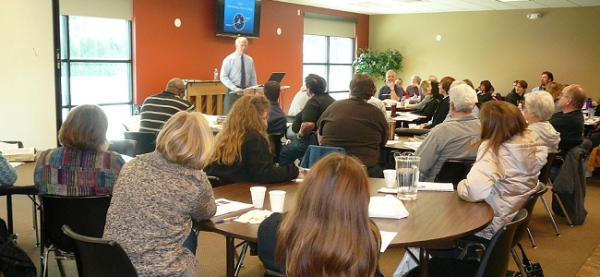"It will be recognising the talent in your colleagues and convincing them to lead workshops which is the biggest challenge."
I’ve organised Teaching and Learning Days for others, and they were hugely successful. Why hadn’t I thought of doing that in school? What could possibly be different? I have a captive audience, some excellent rooms in which to have workshops. Great teachers willing to lead those workshops. And permission from the headteacher. When you convince yourself that ‘that could never happen in my school’, you become blind to the fact that many others are waiting for the same thing.
To organise a whole school learning and teaching morning takes two things; time and determination. And a smile. Okay three things. Dabbling with Google Docs will sort out your sign up system very easily, but it will be recognising the talent in your colleagues and convincing them to lead workshops which is the biggest challenge. That might mean you need to reach outside your comfort zone and approach teachers you don’t really know, or those who may seem very hesitant or reluctant to present to their colleagues.
Before long, you’ll have a dedicated team of presenters and are good to go. I had fifteen in the end; more would have been great, but you start with what you can get. There would be three slots with ten workshops at a time, each lasting forty minutes: twenty five minutes for presentation, fifteen of discussion. Most would present twice. The final, fourth session, would be one for reflection and next steps. What have we learned today and how can we use it?
And in the end you have a staff who become animated and engaged, many for the first time in years. Meticulous organisation means the day goes smoothly. What has been missing in the staff room is not merely access to quality CPD but the confidence to talk about what we do on a day-to-day basis. Overly assessed, crushingly bureaucratic, we have lost that buzz about teaching, that self-efficacy that reminds us we are professionals doing a difficult but important job. We have lost the vocabulary to question each other critically, to support each other in our attempts to change. What I found was that one morning could begin to change that, to get it back. The success of the day has, I think, changed the culture of the school, hopefully forever.
"All CPD should be about making us better so we can help the pupil to be better."
Of course, everything we do ultimately is for the good of the children who pass through our classrooms. All CPD should be about making us better so we can help them to be better. But does that focus, perhaps, lead us away from the discussions we must have about and with each other? The desire to collaborate on Twitter might suggest that teachers are ready and willing to take control of our own development but, in reality, social media caters to a tiny percentage of educators. What I have tried to do is to take that spirit of sharing, collaboration and development into school and it seems to have worked.
So, what happens next? Since that day, I have developed a school CPD blog where all materials from the day are collected and all staff can place ideas, presentations, links from which others may benefit. It’s a start, but we are beginning to come together as a group. We are beginning to appreciate the talent we have in our teaching staff and the huge bank of knowledge and experience we can tap into. That common assumption that CPD is better served-in house is becoming a reality.
What I’ve learned is that if we are unhappy with the status quo then we have choices: you can fight a system which you cannot beat unless you join it, and that will make you very unhappy; you can portray the illusion that you are a rebel and question the system from the outside - you will look like a fool and, more often than not, end up unhappy; or you can smile, play the game and take control of your own development, carving out a role for yourself. Think about what you really want to do and do it anyway. Others will thank you. You may even change things forever.
How do you handle in-house CPD? Let us know in the comments!


















